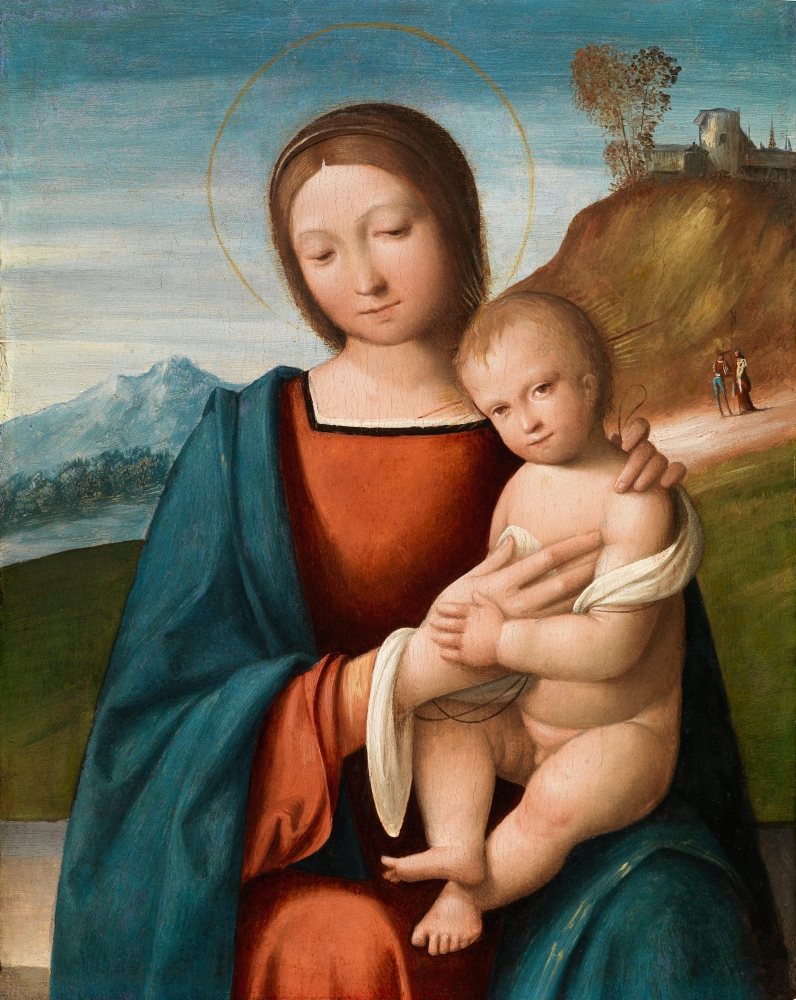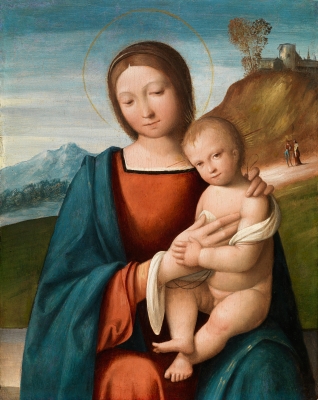The Electorate of Bavaria (according to a seal on the reverse);
Art Market, Switzerland, c. 1995, where acquired by a private collection;
By whom sold, New York, Christie’s, 30 October 2018, lot 109, where acquired by the present owner.
A. Pattanaro, in Ioanes Ispanus. La Pala di Viadana. Tracce di classicismo precoce lungo la valle del Po, exh. cat., (ed.) M. Tanzi, Viadana 2000, p. 143, reproduced in colour on p. 145.
Click here to download the factsheet
This exquisite work, which recently appeared on the American market, was correctly recognized first by Alessandra Pattanaro[i] and later by Anna Maria Fioravanti Baraldi, author of the most recent monograph on the Ferrarese artist, as an early work by Benvenuto Tisi, known as Garofalo, one of the major representatives of the Este school of painting during the sixteenth century.[ii]
The discovery by Adriano Franceschini of the young artist's apprenticeship contract, later published by Emanuele Mattaliano, has shed new light on the various stages of Garofalo's training. He was traditionally considered a pupil of the Ferrarese painter Domenico Panetti, then a follower of Boccaccio Boccaccino and finally an assistant of Lorenzo Costa at the court of Mantua, on the basis of what is narrated in the Lives by Giorgio Vasari, who was an acquaintance and friend of Tisi.[iii] According to the rediscovered document, in October 1497 Garofalo was entrusted for a three-year apprenticeship with Boccaccio Boccaccino of Cremona.[iv] The latter had just moved from Milan to Ferrara thanks to Antonio Costabili, who obtained grace from prison for him through Duke Ercole I d’Este. Although Boccaccino’s permanent presence in the city was brief, having already concluded in February 1500, he left an indelible mark on the local pictorial school. He influenced the production of a new generation of artists working on numerous ducal commissions, among whom Garofalo distinguished himself early on, earning the favour of Antonio Costabili and occupying a prominent place in the local artistic panorama next to Dosso.
The research of various scholars has been fundamental in interpreting the juvenile production of Garofalo. We should recall in the first instance Elisabetta Sambo,[v] as well as Andrea Ugolini and Alessandra Pattanaro;[vi] the latter built on the chronology reconstructed by Alessandro Ballarin[vii] and has studied the artist in various phases, with a focus on the cycle of the Treasury Room of Palazzo Constabili, also referred to as Palazzo di Ludovico il Moro, in Ferrara.
The painting in question can be compared to other early works in the painter's catalogue, datable to the end of the first five years of the sixteenth century, such as the Annunciation from the Giorgio Cini Foundation in Venice (inv. 6270) and The Madonna and Child Enthroned with St Martin and St Dorothea, formerly in the parish church of Codigoro, Ferrara, and today in the Uffizi Gallery in Florence (inv. Deposito 6), both dated by critics to this time, around 1505, marked by the painter's adhesion to his lessons from Lorenzo Costa, perceptible even in the rendering of physiognomic features, as in the face of the Virgin. In the same way as Costa did, the oval is drawn by the parting of the hair that falls to the sides of the face, covering the ears, to end up softly gathered at the nape of the neck; the half-closed eyes are traced with delicate brushstrokes and, like shallow slits, they follow the line of the lips. The essentiality and clarity of the features underline a still immature and ethereal beauty. Even some details of the clothing, such as the neckline of the dress and the trick of making an abundant portion of the shirt appear from the sleeve, are almost identical across works of this period.
The Madonna seated on a simple marble base, barely visible in the lower left, stands out against a landscape still reminiscent of those of Boccaccino, with blue mountains on one side and a meadow on the other, behind which rises a mountain populated by sparse vegetation and a few buildings dominated by a circular tower. Despite the small format, the figures of a soldier holding a halberd and of a woman, stopped on the road at the foot of the hill, are clearly legible. The wooded valley, bordered by a stream, refers to the rarefied atmospheres of Costa, the master to whom Garofalo looks to in this phase of his artistic transition.
The proximity of the Madonna exhibited here to that of the Cini Annunciation, coming, according to the testimony of Carlo d'Arco,[viii] from the monastery of the nuns of San Cristoforo in Mantua, offers the opportunity to once again evaluate the hypothesis, already suggested by critics, of an early Mantuan stay by Garofalo, around 1506, when the artist could have followed Costa, who had been called to the city to replace Mantegna. This hypothesis is also confirmed by the frieze with Putti holding up a plaque with a battle scene, conserved in Palazzo Ducale (inv. 100966), a work that seems reasonably attributable to Tisi.[ix] The panel, which re-emerged in 1990 following works at the Armeria Hall, could – as suggested by Stefano L'Occaso, who, summarizing the critical history of the painting, entirely limited to Mantegna's circle, attributes it to an anonymous artist from Mantua – be reused material, coming from another part of the building.[x]
The importance of the Garofalesque prototype examined here, or perhaps of a model attributable to Costa, can be measured by examination of the example of the Madonna del latte, today in the Walker Art Gallery in Liverpool and published by Andrea Ugolini as a work by Tisi,[xi] but of lower quality and rightly excluded in the artist's catalogue, which shows a close relationship to the work in question.
The present panel by Garofalo, excellently preserved, has revealed its preparatory drawing, outlined with a confident black stroke, in the lighter parts of the complexion of the Madonna's face and in the body of the Child. Although there is a wax seal on the back of the work, identified with the coat of arms of the Electorate of Bavaria, it has not yet been possible to recover documentary evidence useful for clarifying the previous provenance of the painting.
Valentina Lapierre
[i] See Ioanes Ispanus. La Pala di Viadana. Tracce di classicismo precoce lungo la valle del Po, exh. cat., (ed.) M. Tanzi, Viadana 2000, p. 143.
[ii] A. M. Fioravanti Baraldi, Il Garofalo. Benvenuto Tisi pittore (c. 1476 - 1559). Catalogo generale, Rimini 1993.
[iii] E. Mattaliano, ‘Benvenuto Tisi da Garofalo. Documenti inediti’, in Da Borso a Cesare d’Este. La scuola di Ferrara 1450-1628 (Italian edition of the exh. cat., London 1984, then enhanced after the symposium in the summer of 1984 at the Courtauld Institute of Art), Ferrara 1985, pp. 170-171.
[iv] Concerning Boccaccino’s stay in Ferrara, see A. Pattanaro, ‘La "scuola” di Boccaccino a Ferrara’, in Prospettiva, 64, 1991, pp. 60-74.
[v] E. Sambo, ‘Sull’attività giovanile di Benvenuto Tisi da Garofalo’, in Paragone, 395, 1983, pp. 19-34.
[vi] We should remember the contributions of A. Pattanaro, ‘Alcune precisazioni e nuove proposte per il catalogo di Benvenuto Tisi detto il Garofalo’, in Annali della Fondazione di studi di storia dell'arte Roberto Longhi, III, 1996, pp. 51-61; A. Pattanaro, ‘Una "Sacra Famiglia” del giovane Garofalo e un appunto sul Costa a Ferrara’, in Prospettiva, 136, 2009, pp. 31-34.
[vii] A. Ballarin, Dosso Dossi. La pittura a Ferrara negli anni del ducato di Alfonso I, Registries and catalogue apparatus edited by A. Pattanaro & V. Romani, with the collaboration of S. Momesso & G. Pacchioni, ‘Pittura del Rinascimento nell’Italia settentrionale, I’, ‘Dipartimento di Storia delle Arti Visive e della Musica, Università di Padova’, 2 vols., I (1995), II (1994), Cittadella (Padua) 1994-1995, II, in particular following the sections ‘Boccaccino a Ferrara e a Venezia (1497-1506)’ and ‘La pittura a Ferrara nel primo decennio del Cinquecento’.
[viii] C. d’Arco, Monumenti di pittura e scultura trascelti in Mantova o nel suo territorio, Mantua 1827, pp. 13-14.
[ix] See R. Cara & V. Lapierre, Novità su alcuni dipinti ferraresi nei musei di Mantova, publication in progress.
[x] S. L’Occaso, Museo di Palazzo Ducale di Mantova. Catalogo generale delle collezioni inventariate. Dipinti fino al XIX secolo, Mantua 2011, pp. 135-136, cat. no. 83.
[xi] A. Ugolini, ‘Ancora sul Garofalo giovane’, in Paragone, 417, 1984, pp. 61-65.

